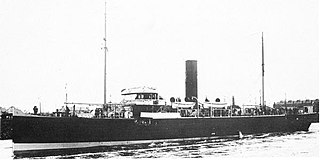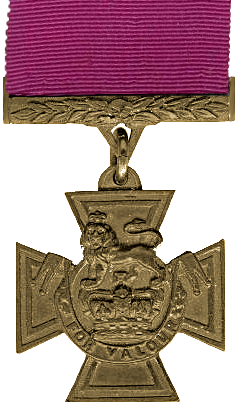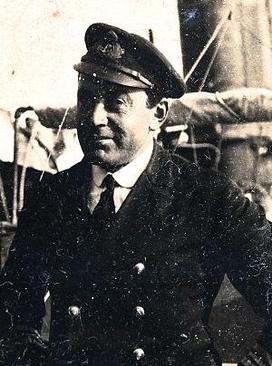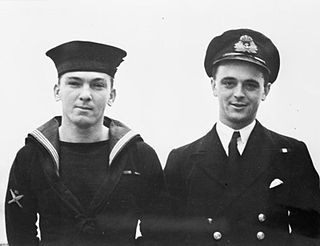
Q-ships, also known as Q-boats, decoy vessels, special service ships, or mystery ships, were heavily armed merchant ships with concealed weaponry, designed to lure submarines into making surface attacks. This gave Q-ships the chance to open fire and sink them.

Flying Officer Lloyd Allan Trigg VC DFC, of Houhora, New Zealand, was a pilot in the RNZAF during World War II. He was a posthumous recipient of the Victoria Cross, the highest award for gallantry in the face of the enemy for British and Commonwealth armed forces, and received the award for pressing home an attack on a German U-boat in August 1943. He was killed in the action. His award is unique, as it was awarded on evidence solely provided by the enemy, for an action in which there were no surviving Allied witnesses to corroborate his gallantry.

Vice Admiral Richard Bell Davies, also known as Richard Bell-Davies, was a senior Royal Navy commander, naval aviator, and a First World War recipient of the Victoria Cross, the highest award for gallantry in the face of the enemy that can be awarded to British and Commonwealth forces.

USS Grayback (SS-208), a Tambor-class submarine, was the first ship of the United States Navy to be named for the lake herring, Coregonus artedi. She ranked 20th among all U.S. submarines in total tonnage sunk during World War II, with 63,835 tons, and 24th in number of ships sunk, with 14. She was sunk near Okinawa on 27 February 1944. Her wreck was discovered in June 2019.

Commander Harold Auten was a Royal Naval Reserve (RNR) officer who was awarded the Victoria Cross, the highest award for gallantry in the face of the enemy that can be awarded to British and Commonwealth forces. He received his medal for an action during the English Channel campaign of the First World War.

Geoffrey Saxton White VC was an English Royal Navy officer and recipient of the Victoria Cross, the highest and most prestigious award for gallantry in the face of the enemy that can be awarded to British and Commonwealth forces.

William Edward Sanders was a First World War New Zealand recipient of the Victoria Cross (VC), the highest award for gallantry "in the face of the enemy" that could be awarded to British and Commonwealth forces at the time.

Commander Donald Cameron, VC was a Scottish sailor and a recipient of the Victoria Cross, the highest award for gallantry in the face of the enemy that can be awarded to British and Commonwealth forces. He is one of three VC recipients from the small town of Carluke in South Lanarkshire. The Rotary Club of Carluke have erected a millennium stone in the town market place to commemorate this.
Thomas William Gould, VC was a Royal Navy sailor and a recipient of the Victoria Cross, the highest award for gallantry in the face of the enemy that can be awarded to British and Commonwealth forces. He was one of three Jewish recipients of the Victoria Cross in the Second World War.

James Joseph Magennis, VC was a Belfast-born sailor and recipient of the Victoria Cross, the highest award for gallantry in the face of the enemy that can be awarded to British and Commonwealth forces. He was the only native of Northern Ireland to receive the Victoria Cross in the Second World War.

Chief Petty Officer Ernest Herbert Pitcher was a Royal Navy (RN) sailor and an English recipient of the Victoria Cross (VC), the highest award for gallantry in the face of the enemy that can be awarded to British and Commonwealth forces.

Commander John Wallace Linton, was a Royal Navy submariner and a Welsh recipient of the Victoria Cross, the highest award for gallantry in the face of the enemy that can be awarded to British and Commonwealth forces. Nicknamed "Tubby", he was a fine Rugby football forward, playing for the Royal Navy, United Services, and Hampshire County teams.

Rear Admiral Eric Gascoigne Robinson was a Royal Navy officer and a recipient of the Victoria Cross. He earned his award by going ashore and single-handedly destroying a Turkish naval gun battery while a lieutenant commander with the fleet stationed off the Dardanelles during the Gallipoli campaign in the First World War.

Rear Admiral Basil Charles Godfrey Place,, known as Godfrey Place, was an officer in the Royal Navy and a recipient of the Victoria Cross, the highest award for gallantry in the face of the enemy that can be awarded to British and Commonwealth forces.

Admiral Sir Martin Eric Dunbar-Nasmith, was a Royal Navy officer and a recipient of the Victoria Cross, the highest award for gallantry in the face of the enemy that can be awarded to British and Commonwealth forces. He was born Martin Eric Nasmith, adding "Dunbar" to his surname in 1923.

Rear Admiral Sir Anthony Cecil Capel Miers,, known as "Crap Miers" and "Gamp", was a Royal Navy officer who served in the submarine service during the Second World War.

HMS Torbay (N79) was a T-class submarine of the Royal Navy. She was laid down at Chatham Dockyard and launched on 9 April 1940.

HMS Thrasher (N37) was a T-class submarine of the Royal Navy. She was laid down by Cammell Laird & Co Limited, Birkenhead, launched in November 1940, and had an active career in the Mediterranean and Pacific Far East.

Vice-Admiral Sir Arthur Richard Hezlet, nicknamed Baldy Hezlet, was a decorated Royal Navy submariner. He became the Royal Navy's youngest captain at the time – aged 36 – and its youngest admiral, aged 45. In retirement he became a military historian.

Vice-Admiral Sir Hugh Stirling Mackenzie, was a Royal Navy officer who became Flag Officer Submarines and Chief Polaris Executive.



















